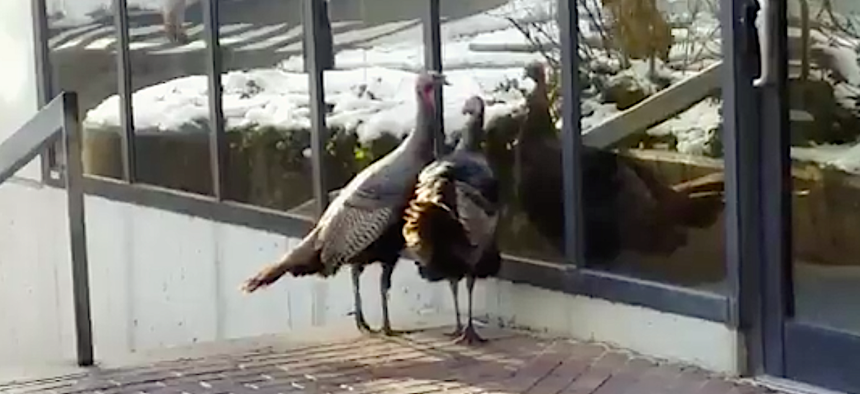Wild Turkeys Drawn to Their Reflection Highlight an Unusual Human Policy Challenge

Wild turkeys on the move in Cambridge, Massachusetts on Sunday afternoon outside an Au Bon Pain location. Michael Grass / Route Fifty
Building design can easily confuse avian creatures. Here are steps to keep birds of various feathers from flocking together where you don’t want them.
CAMBRIDGE, Mass. — Walking toward Harvard Square on Sunday afternoon, a small group of people gathered outside an Au Bon Pain location on Massachusetts Avenue, drawn to a small brick plaza tucked between an unremarkable five-story office building and the slushy sidewalk. But they weren’t there to queue up for Au Bon Pain’s seasonal soups and filling sandwiches.
They had, just like me, stumbled upon two wild turkeys strutting their stuff outside the Au Bon Pain and an adjacent bank of shiny windows. The turkeys were apparently drawn to their reflections, periodically banging their heads on the glass. Across the street, there was an audible gobble coming from somewhere and sure enough, a third turkey soon joined them.
This is not an uncommon scene in Cambridge—a girl and her dog were chased by a wild turkey earlier this year as was a city councilor—nor is it an uncommon scene in other parts of the nation. Wild turkeys have been recently menacing the town of Mendon, Utah and cities in the San Francisco Bay Area, just to name a few.
Unlike rural areas where wild turkeys can be shot by hunters, targeting the birds in more urbanized areas can be far more difficult. The mayor of Chenoa, Illinois, has been feeling the heat after he obtained state permission to hunt wild turkeys roaming around town that had become both beloved local celebrities and annoying nuisances.
But there’s a side issue here beyond the wildlife management challenges many local government officials are dealing with when it comes to turkeys causing trouble in their jurisdictions: window design.
Reflective windows can easily confuse birds. While that may seem relatively harmless—and entertaining—when it involves wild turkeys, it can be deadly for birds while in flight. In fact, according to the Audubon Society of Portland, Oregon, 1 billion birds die in the United States annually after flying into windows.
Last year, Route Fifty stumbled across a helpful public information campaign outside a community center in Portland detailing the reasons why birds fly into windows and ways to reduce the risk to birds:
- "Window reflections show sky and trees that birds see as a clear flight path through the glass.”
- “Landscape seen through an opposite window appears to birds as a continuation of the outdoors.”
- “Artificial lights confuse and attract night-migrating songbirds, and can result in fatal collisions.”
- “In defense of their breeding territories, birds may attack their own reflections in the glass.”
- Reduce reflections by using “one-way non-reflective films on outside of windows,” incorporating “recessed windows into building designs” and "treat glass with non-reflective surfaces or etched designs”
- Create soft surfaces for birds outside of windows by using screens all year long and attaching small-mesh netting 2-3 inches from the glass.
- And create visual barriers by putting obstacles in front of windows, like hanging old CDs or wind chimes. Also, “dirty windows save lives,” which might be a good way to save money for a cash-strapped municipality.
The more you know ...
Michael Grass is Executive Editor of Government Executive’s Route Fifty and is based in Seattle.
NEXT STORY: Trump’s Budget Cuts Could Make N.Y.C. Commuters Even More Vulnerable to Attacks






